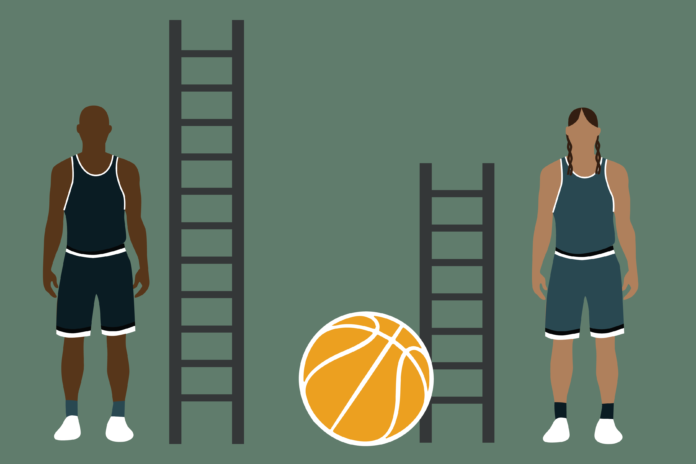As players prepared for the biggest tournament of their lives, controversy shined a spotlight on the gender inequalities within college sports
The treatment of men and women in collegiate athletics has long been a topic in discussions over gender inequality. Many more examples of gender disparities among the National Collegiate Athletic Association (NCAA) have remained hidden for years, but new findings during the most recent NCAA tournament has brought the issue back into the spotlight.
Last month, the University of Oregon women’s basketball sophomore Sedona Prince posted a video on the social media app TikTok that went viral. This video had approximately 7 million views at the date of publication, and presents a comparison between male and female basketball weight rooms during the NCAA March Madness tournaments. The women’s weight room consisted of only a weight rack and a few yoga mats, while the men’s room had access to an entire gym full of squat racks, dumbbells and other equipment.
After numerous images surfaced on social media showing the drastic differences between the women’s and men’s facilities in Texas and Indiana respectively, the NCAA apologized for causing the female athletes any inconvenience and upgraded the women’s weight room.
“We fell short this year in what we’ve been doing to prepare in the last 60 days for 64 teams to be here in San Antonio, and we acknowledge that,” said Lynn Holzman, the NCAA’s vice president of women’s basketball.
Part of the problem is that the NCAA has a committee that focuses on Title IX—with the Women’s Basketball Coach Association (WBCA) also a part of it—but they have been left out recently. They are vocal when these issues come up, but remain frustrated that they have been cut out of any decisions.
Title IX states,“No person in the United States shall, on the basis of sex, be excluded from participation in, be denied the benefits of, or be subjected to discrimination under any education program or activity receiving Federal financial assistance.” This applies to any institution receiving federal financial assistance from the U.S. Department of Education.
Val Ackerman, who was the founding president of the WNBA and is currently commissioner of the Big East Conference, called the WBCA “fragmented and frustrating” because whenever she reported instances of inequality, there never was any change.
“It is a Tower of Babel,” Ackerman said. “Trying to get the right people at the table, how to get consensus around who you can trust to make the right decision is really challenging.”
According to ESPN, the 2018-19 NCAA Division I men’s tournament had a budget of $28 million, which was almost double the women’s budget of $15.5 million. The NCAA provided additional information that showed the men’s net income of $864.6 million that season and the women’s event lost $2.8 million—the largest loss of any NCAA championship.
Women’s basketball does not bring in the same amount of money, potentially in part because, despite the growing number of women’s sporting events, the media’s coverage of them is still very minimal. Women make up nearly 40% of all sports participants— yet, according to a study by the Tucker Center for Research on Girls & Women in Sport at the University of Minnesota, women only received 4% of the sports media coverage. Women are not being streamed as much as men on television or any other media outlets, causing a decrease in revenues that makes it hard to allow any financial improvement.
“One of the things we can do right away, is to call the tournaments ‘the Men’s Basketball Tournament’ and ‘the Women’s Basketball Tournament’,” said Muffet McGraw, former women’s basketball coach at Notre Dame. “When you turn on the TV and you look at the guide it just says NCAA Basketball Tournament, and of course that just means men’s. The NCAA runs two social media accounts, one called March Madness, one called The Final Four, and of course they’re both men’s. They don’t state that.”
After the most recent incident with Prince and the gyms, the NCAA hired a law firm to help examine all championships for all the divisions. Financial evaluations are being made and they are also trying to identify “any other gaps that need to be addressed, both qualitatively and quantitatively, to achieve gender equity.”
When considering the complexity of college sports, the NCAA has many deeply rooted organizational issues. Nevertheless, the NCAA clearly has several different avenues and approaches they could take to improve women’s athletics.
Without Prince’s video and the public scrutiny and attention it brought the NCAA, they would have not given women a proper facility during the biggest tournament of the year. This experience has inspired many people, not only women, to have the courage to fight for justice and equity.
“I think this is an awakening that probably needed to happen. I think it will jump start more change,” Ackerman said.
Written by: Katherin Raygoza —sports@theaggie.org





